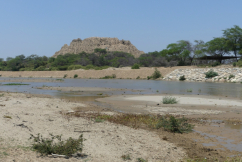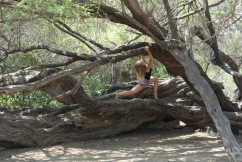On the 26th my partner, his mom and I went on a trip to the Historic and Natural Sanctuary of the Pómac forest where there are many species of trees (mainly carob tress) and birds and where one can admire the huacas (archaeological remains of ritual places) of the Sicán pre-Inka culture and at night even pumas.
Pomác is located in a dry area near the coast, and is composed of the densest concentration of carob trees on the planet. It also homes sapote fruit and many bird species and stands a group of thirty-six pyramids that once formed part of the kingdom of the Sicán culture.
Rich in History
This culture, also referred to as Lambayeque culture, inhabited what is now the north coast of Peru between about 750 and 1375. It succeeded the Moche culture. There is still controversy among archeologists and anthropologists over whether the two are separate cultures. The Sican culture is divided into three major periods based on cultural changes as evidenced in archeological artifacts. Sican supposedly stands for “temple of the Moon”.
The Sicán were one of the most powerful civilizations in Peru. Inside the Pomac pyramids, they have found various pieces made of gold that are linked to the legends of Naylamp, the priestess of Chornancap, the Lord of Sicán and the iconic Gold Tumi. It is not known for certain whether the pyramids were temples, mausoleums, dwellings or workshops. But the many gold objects found in the interior of these structures survive as testimony to the grandeur of Lambayeque culture.
Rich in Nature
The main objective of the people who take care of this sanctuary is to preserve the landscape and natural wealth. Its extensive biodiversity with more than 95 different species of birds, many of them endemic, and the dry forest ecosystem that you can find in its interior, make it the ideal place to preserve the carob trees, a tree of the legume family.
That is why biology lovers and tourists who enjoy bird watching choose the Pomac Forest as one of the favorite places to visit Peru. However, it is not necessary to be an expert in the field to appreciate the surroundings of this sanctuary, which is home to unique species such as the Peruvian cuttlefish, the Tumbes swallow, the wild cat or the rice mouse, among others.
How to get there?
The best way is by renting a car in Chiclayo or Lambayeque. The drive will take about 1 hour and 20 minutes and you can buy some San Roque (King Kong) blissful desert in the company of the same name seated in Lambayeque. They have a lovely little store there and a small café attached.
Useful information
The place can be visited any time of the year as I has a very pleasant climate and temperatures of in between 18 ℃
– 32 ℃ all year around.
Opening Hours: 8: 30-17: 30
Price: Foreigners: S / 30, Adults: S / 11, Children: S / 5, Parking: S / 5
Indispensable: repellent, sunscreen, sportswear, comfortable walking shoes, hat, sunglasses, water bottle, cash











